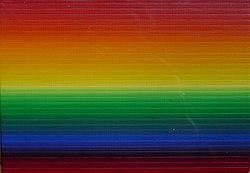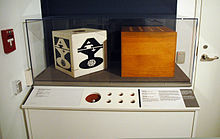
Quick Facts

Biography
Takao Iijima (born May 19, 1931), better known by his art name Ay-O, (靉嘔) (Museum of Modern Art page [1]) is a Japanese artist who has been associated with Fluxus since its international beginnings in the 1960s.
Biography
From Democrato to Fluxus
Probably, the best reference to understand the early years of Ay-O is the autobiographical retrospective book in the references "Ay-O, Over the Rainbow, Ay-O Restrospective 1950-2006." In a nutshell: Ay-O started his career in the Demokrato Artist Association (デモクラート美術家協会), created by Ei-Q. This association promoted artistic freedom and independence in making art. The influence of these values with Ay-O can be seen in a series of early paintings over which he painted a large X because he thought they were not original enough. Another independent movement was close to Democrato in Japan: Sōzō Biiku (創造美育) by the collector Sadajirō Kubo (久保貞次郞) promoting nurturing freedom when teaching art. Both movements started Fukui Prefecture in Japan and explain the special bound Ay-O developed with the Fukui Prefecture. Sōzō Biiku's approach is a challenge of the traditional Japanese Master-Student relationship. As such, like naive art, the movement promotes ways independent to the culturally established ones. Kubo also created the "Small Collector Society" (小コレクターの会) to spread art collection in society. Some of the works from this period in the 50s show an influence from Fernand Léger with massive bodies on the canvas (like for example the massive (1.83mx3.7m) Pastoral (Den'en) from 1956 [1][2]).
Ay-O was introduced to George Maciunas by Yoko Ono in 1961 and formally joined Maciunas in Fluxus in 1963. Ay-O was known for his Finger Boxes and for his performance events when he was active in Fluxus. He worked closely with fellow Fluxus artists Maciunas, Emmett Williams, Dick Higgins and Nam June Paik. Ay-O and Nam June Paik were roommates (and became friends) in this Soho fluxus style coop at the time.
The Rainbow Artist
Ay-O established a reputation in the avant-gardes of Japan, Europe and the United States. In Japan, he is known as the "Rainbow Man" for his use of colorful, rainbow-striped motifs in his artwork. In its purest form, some paintings are simple gradations of the rainbow, with up to 192 gradations.

Ay-O represented Japan at the Venice Biennale in 1966 and at the São Paulo Biennale in 1971. He also built the famed "Tactile Rainbow" at the Osaka World's Fair in 1970. In 1971, true to his Demokato debut, he adapted 10 American Naïve paintings and created a rainbow version that he called Nashville Skyline. Ay-O's attachment to Douanier Rousseau's work is another proof of his interest for naïve art. In 1987 he did a series of Rainbow Happenings, with Rainbow Happening #17 being a 300m Rainbow Eiffel Tower project in Paris. As a rainbow artist Ay-O's work embraces abstraction more decisively than in his previous period, and human form when present in a rainbow context becomes itself abstract.[3] One special work from the period 8:15 A.M. (1988), done for Hiroshima's MOCA represents the explosion with his Rainbow palette [4].
Recent Activities
One of his projects in English was a Collective Portrait of George Maciuanas, that he co-edited with Emmett Williams and Ann Noel. In the recent decade Ay-O has exhibited regularly at the Emily Harvey Gallery in (1996, 2001) and Gallery Itsutsuji (1996,2005,2007,2012) and Gallery Goto (1999,2004) in Japan. In Japan Ay-O is part of the collection of the National Museum of Modern Art in Tokyo and Kyoto (see 2005 Tokyo exhibition in the links). In 2001 Ay-O had a room in the special exhibit "La fluxus Constellation" in the Museum of Contemporary Art in Genoa. He was also represented in various other Fluxus exhibitions around the world as "Centraal Fluxus Festival" Centraal Museum, Utrecht (2003), "Fluxus & Non Fluxus Fluxus" Randers kunstmuseum (2006). Being present at both the Venice Biennale in 1966 and at the São Paulo Biennale in 1971, Ay-O was one of the "Twelve Japanese Artists from the Venice Biennale 1952-2001," in Art Tower Mito ATM, Mito. At the Mori Art Museum, Tokyo, Ay-O was part of two exhibitions: "Tokyo-Berlin / Berlin-Tokyo" in 2005 and "All about laughter" in 2007. Finally in 2012 the MUSEUM OF CONTEMPORARY ART TOKYO (MOT) showed a large retrospective exhibition: "Over the Rainbow once more."[5][6] [7] [8] This was followed by the retrospective being shown at the Hiroshima City Museum of Contemporary Art through to 14.1.2013.[9][10][11][12]. The 300m Rainbow from Happening #17 was part of the show [13]. Hiroshima's MOCA exhibit was the occasion of one more happening performed by Ay-O and his team : a Fluxus revival performance, succession of 30 shorts representing each a different Fluxus artists Video on YouTube. This was Ay-O's way to celebrate the 50's birthday of Fluxus, and a Japanese echo the Wiesbaden events [14][15][16]. In 2012 the MOMA produced an exhibit titled : Tokyo 1955-1970 Avant Garde where Ay-O's work in that period are presented.[17]
Fukui (2006) and Japan (2012) Retrospective
Ay-O did his most complete retrospective exhibitions in Japan - first in the Fukui Art Museum in 2006 organized the first retrospective. This exhibition was the occasion for the artist to write a bilingual book "Over the Rainbow, Ay-O Restrospective 1950-2006," in which he provides an overview of his work. In 2012 similar retrospective augmented by recent works "Ay-O: Over the Rainbow Once More" is shown in various locations in Japan (e.g., [18]) - the inaugural exhibit was in the Tokyo MOT [19]. The catalog of the 2012 exhibits clarifies a few points of the reference book from the 2006 exhibit.
Finger boxes

The Finger Boxes are works of art by Ay-O that are the most tactile works of art in the Fluxus project. Ay-O first produced them in 1964. There are rumors that they were invented before WWII, however this is unconfirmed. It is said that all of the original Finger Boxes were destroyed during the fighting. Ay-O is said to have learned of this and claimed the invention for himself. The artworks comprise largely identical hollow cubical wooden boxes with finger-sized holes in one face. As tactile works of art, it is necessary to touch them to perceive them, by placing one's finger into the hole to feel the material that is hidden within the box. The hidden contents of the boxes comprise such various things as beads, bristle brushes, hair, cotton balls, nails, and sponges.[1]
The artist's intent, by including things such as nails, which can potentially prick the finger, in the possible contents of the box is to ensure that the user touches the box with an "enquiring, learning gesture". The finger boxes are also intended to be touched by multiple people at a time, promoting a shared, social, experience of perceiving the work.
Several versions of the Finger Box exist, including one set of boxes in a briefcase (entitled Finger Box (valise edition)) which is in the Gilbert and Lila Silverman Fluxus Collection in Detroit, and a version (included in Fluxus I) that uses sealed envelopes that have been slit open instead of boxes.
In the 2012 Japan retrospective, "Over the Rainbow once More" - a larger work is presented around the finger boxes—it is a cubic room in which the viewer/toucher enters. The wall of this room is paved with square rainbow motifs - where concentric squares with the colors of the rainbow are painted around a hole in the wall. Behind each hole a finger box as been appended on the other side.
Prints
True to his Japanese beginning and the Democrato movement Ay-O took some special care to produce print version of his work. Some of his work exist both as oil on Canvas and print (96 gradations for example). Ay-O personally gets involved in the process. Examples can be seen here [1]. Prints are a way to paint rainbows as one. In a way similar to the execution of the Nashville Skyline (where the color was applied by others), Ay-O use number coding to communicate with his printers, 12 is lemon yellow, 1 red, 24 purple. The rainbow is then the consecutive integers.[2][3] In prints inspired from the shunga tradition, as for example `Ten komanda no zu, kōbutsu 十開の圖 虹佛 (Depiction of the Ten Commandments, Rainbow Buddha) ' Rainbow Hokusai, 1970, from the British Museum Collection [4], the printing technique assembles 54 separate square cards, each printed with part of the design.
Happenings

Happenings are a tradition from the Fluxus movement.[1] Many fluxus members organise or participate in such happenings. One remembers Piano Activities and Yoko Ono Cut Piece. Ay-O has participated and organised such happenings since the 60's and continues until recent times. The early happenings were all over the world. In New-York (1965) in Flux Hall "Memoriam of Adriano Olivetti," "Rainbow Staircase Environment, 363 Canal Street, New York, November 20" [2], "Rainbow Music #1," Tokyo (1966) "Happening for a sightseeing bus trip in Tokyo" with its movie on the moma website [3], Fukui (1986) Rainbow Happening #16, a 25-meter rainbow in the Eiheiji Temple, Paris (1987) Rainbow Happening #17. A happening was part of his 2012 retrospective, and for the Rainbow Dinner the same year.

Organised by Ay-O the rainbow pro-eminently figures in such happenings. In both the 2006 [4] and the 2012 retrospectives some theme mixing traditional fluxus themes (like 'One for Violin' executed in 2006 by Nam June Paik) - a portable and explosive version of Piano Activities [5][6][7] and Ay-o specific themes are present.

Kappa
As can be seen on some of his T-shirts, Ay-O likes to identify with a mythological creature from Japanese Folklore. The name of the creature is Kappa (folklore). One can see for example Ay-O represented as Kappa on the pastries of his 81st birthday party.

Sometime the Kappa personna appears in works like in these 'fluxus masks' where Ay-o by the simple application of his rainbow palette assimilates a traditional piece of folklore into contemporary art. [1]
Signatures
Ay-O has several phases with different signatures. In older works in the 50's the signature is mostly and traditionally written in plain letters with the date as for example in the 1955 signature.

At the same time in the pre-rainbow period some of the painting were frequently done on wood and the signature is sometime etched in the wood. In this 1954 example it is etched as 'O ai'.

With arrival of the rainbow period in the 80's some new signature is introduced where the O encircles the other letter in a cartouche-like manner like in this example of 1985 on one of the large 96 gradations work.

Last but not least the rainbow artist developed his 'signature signature': the rainbow signature used mostly for autographs and paper. This is one of his mini happenings. To produce it AY-O puts felt-pin pens in his fist with all colors of the rainbow and signs with it as can be seen in this picture of a book signed with the rainbow signature.

On paper Ay-O signs using roman letters and his kanji (靉嘔).

As for the origin of the name from Ay-O's own and most recent retrospective catalog "Over the rainbow once more" (2012), page 75: "Ay-O, an unusual pseudonym for a Japanese, was conceived during Ay-O's third year at Tokyo Kyoiku University, when he had his friends choose then favorite sounds from the Japanese syllabary A, I, U, E and O. The result: 'AIO.' To express this name, he selected the kanji character 'ai,' from aitai (靉靆) meaning a scene of drifting clouds, and the kanji character 'ou' (long 'o') from the title of Jean-Paul Sartre's novel. 'Outo' (嘔吐)for ('Nausea')."
Publications
- Mr. Fluxus: A Collective Portrait of George Maciunas 1931-1978, Thames & Hudson, 1998
- Niji: Ai O hanga zen sakuhinshu, 1954–1979, Published in English by Sobunsha
- Ouzel, Chikumasyobo Publishing, 1978
- Ay-O, Over the Rainbow, Ay-O Restrospective 1950-2006 (174 pages) (ISBN 4568103592), Bijutsu Shuppan-Sha (ja:美術出版社), 2006
- Ay-O, Ay-O over the Rainbow once more, (ISBN 978-4906702015) 2012 [1]
